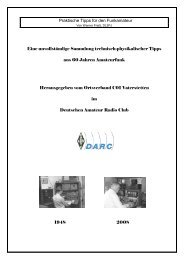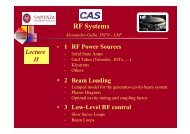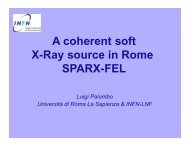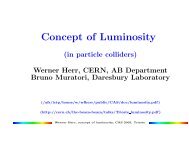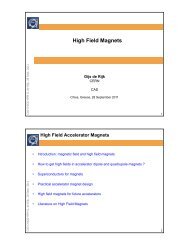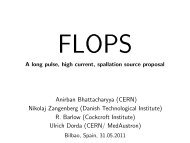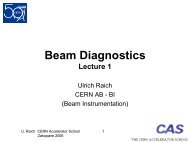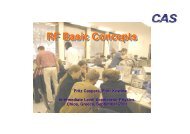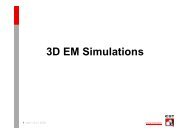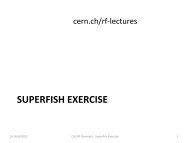mode - CERN Accelerator School
mode - CERN Accelerator School
mode - CERN Accelerator School
You also want an ePaper? Increase the reach of your titles
YUMPU automatically turns print PDFs into web optimized ePapers that Google loves.
Wave velocity: the dispersion<br />
relation<br />
The relation ω(k) can be calculated from the standard theory of waveguides:<br />
ω2 = k2c2 + ω 2<br />
c Plotting g this curve (hyperbola), ( yp ), we see that:<br />
k=2π/λ p<br />
0<br />
ω<br />
1) There is a “cut-off frequency”, below which a wave<br />
will not propagate. It depends on dimensions<br />
(λc=2.61a for the cylindrical waveguide).<br />
vph>c ( c y g )<br />
vph=c<br />
tg α = ω/kz = vph<br />
v ph=ω/k = (c 2 +ω c 2 /k 2 ) 1/2<br />
v g=dω/dk<br />
kz<br />
2) At each excitation frequency is associated a phase<br />
velocity, the velocity at which a certain phase<br />
travels in the waveguide. vp=∞ at k=0, ω=ωc and<br />
then h decreases d towards d vp=c ffor kk,ω→∞.<br />
3) Energy (and information) travel at group velocity<br />
dω/dk, which is between 0 and c. This velocity has<br />
to respect the relativity principle!<br />
4) A particle traveling inside our cylinder has to<br />
travel at v = v ph to see a constant accelerating Efield<br />
→ should travel at v > c !!!<br />
5) To use the waveguide to accelerate particles, we<br />
need a “trick” to slow down the wave. 8



